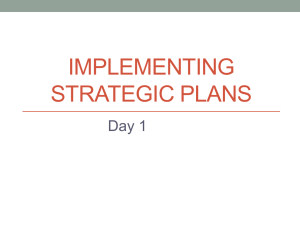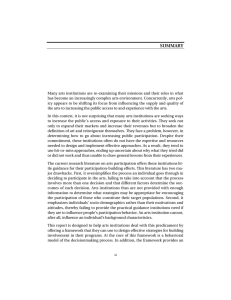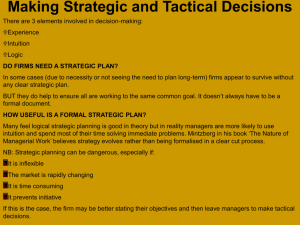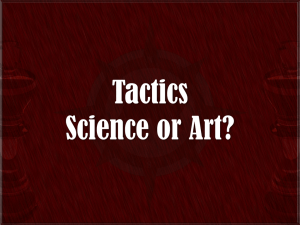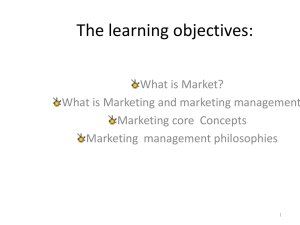INTRODUCTION
advertisement
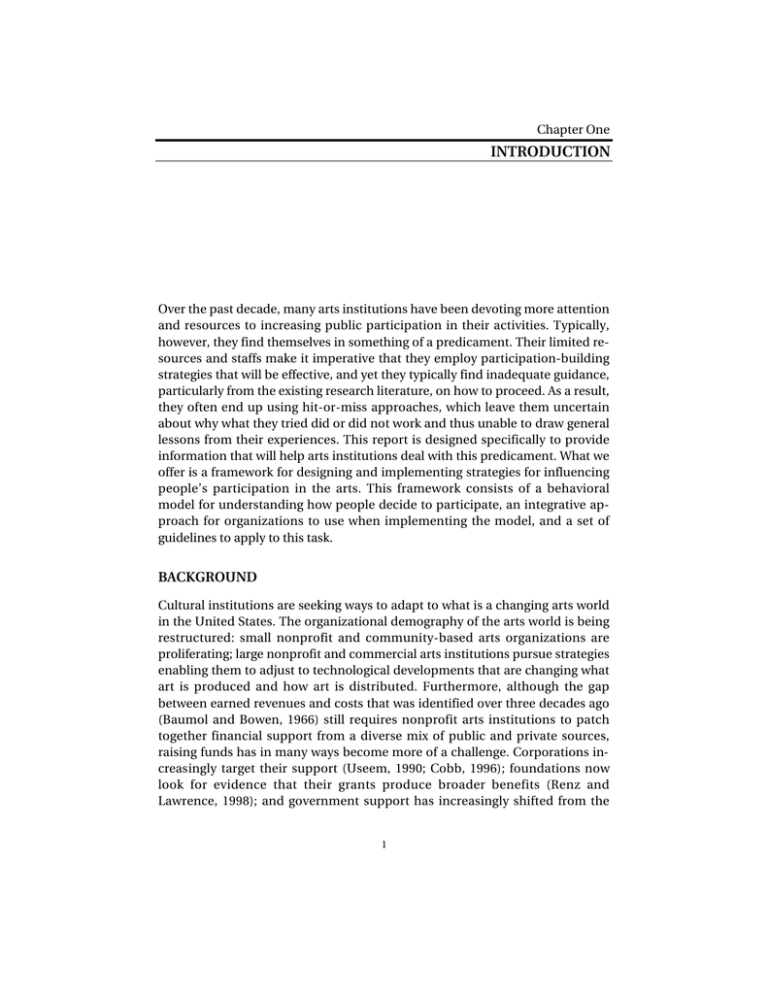
Chapter One INTRODUCTION Over the past decade, many arts institutions have been devoting more attention and resources to increasing public participation in their activities. Typically, however, they find themselves in something of a predicament. Their limited resources and staffs make it imperative that they employ participation-building strategies that will be effective, and yet they typically find inadequate guidance, particularly from the existing research literature, on how to proceed. As a result, they often end up using hit-or-miss approaches, which leave them uncertain about why what they tried did or did not work and thus unable to draw general lessons from their experiences. This report is designed specifically to provide information that will help arts institutions deal with this predicament. What we offer is a framework for designing and implementing strategies for influencing people’s participation in the arts. This framework consists of a behavioral model for understanding how people decide to participate, an integrative approach for organizations to use when implementing the model, and a set of guidelines to apply to this task. BACKGROUND Cultural institutions are seeking ways to adapt to what is a changing arts world in the United States. The organizational demography of the arts world is being restructured: small nonprofit and community-based arts organizations are proliferating; large nonprofit and commercial arts institutions pursue strategies enabling them to adjust to technological developments that are changing what art is produced and how art is distributed. Furthermore, although the gap between earned revenues and costs that was identified over three decades ago (Baumol and Bowen, 1966) still requires nonprofit arts institutions to patch together financial support from a diverse mix of public and private sources, raising funds has in many ways become more of a challenge. Corporations increasingly target their support (Useem, 1990; Cobb, 1996); foundations now look for evidence that their grants produce broader benefits (Renz and Lawrence, 1998); and government support has increasingly shifted from the 1 2 A New Framework for Building Participation in the Arts federal to the state and local levels (DiMaggio, 1991), in the process becoming focused less on the arts per se and more on the social and economic benefits arts bring to local communities. An increase in the supply of arts—particularly the dramatic increase in small nonprofit arts institutions—has sparked a corresponding increase in arts participation (National Endowment for the Arts, 1997). This increase appears, however, to be more connected with amateur “hands-on” arts activities and arts participation through the media than with attendance at live performances. In fact, attendance at live arts performances seems to have remained relatively stable over the past two decades—both in terms of the fraction of the population who attend (attendance rates) (National Endowment for the Arts, 1997) and in terms of their socio-economic selectivity (Robinson, 1993). To adapt to these changes in the arts environment, arts institutions have begun to re-examine their missions and their roles. Moreover, they are facing these challenges at a time when what used to be seen as separate and distinct commercial, nonprofit, and community-based volunteer sectors are increasingly viewed as different elements of a single, diversified arts environment (Cherbo and Wyszomirski, 2000). At the same time, the public debate about arts policy has shifted, moving from what sometimes appeared to be an exclusive focus on public funding for the nonprofit sector to a more general concern with the public benefits of the arts and how each sector of the art world promotes those benefits (American Assembly, 2000). In calling on arts organizations to more explicitly consider and support the public benefits of the arts, the American Assembly acknowledged that the arts community has tended to view arts policy solely in terms of its impact on artists and arts organizations. It also identified broad categories of public benefits at the individual, community, and national levels. The arts serve as a source of entertainment, enrichment, and fulfillment at the individual level. In addition, they can promote openness to new ideas and creativity as well as competencies at school and work. At the community level, the arts can provide a variety of social and economic benefits, such as increasing the level of economic activity, creating a more livable environment, and promoting a sense of community pride. At the national level, the arts express the country’s rich cultural diversity and pluralism, reinforce national identity, and provide an important body of cultural goods for international export. The focus of most arts policy has traditionally been on the “supply side” (Chapman, 1992)—that is, on influencing the quality and quantity of arts available by supporting arts organizations—but the new emphasis on the public benefits of the arts requires that the focus be on the “demand side”—that is, on Introduction 3 increasing the public’s access and exposure to the arts. Thus, for example, the role of the arts as a source of individual entertainment and enrichment and the various instrumental benefits the arts can provide at the individual, community, and national level are predicated on increasing the number and diversity of people who participate as well as the depth of their participation. In this context, it is not surprising that many arts institutions have looked to provide greater service to their communities and to reach out to local populations that traditionally have not participated in their activities. Their goal is not just to expand their market and increase their revenues, but also to broaden their definition of art and reinvigorate themselves. THE PREDICAMENT In setting out to increase public participation in their activities, arts institutions face a series of strategic and tactical choices for which they are often unprepared. At the strategic level, they must decide what their goals are and why. At the tactical level, they must decide how to accomplish their goals. Moreover, most nonprofit arts institutions face severe resource constraints,1 so the strategic and tactical choices they make about goals and approaches will affect not only the success of their participation-building efforts, but also the resources available for programming and other artistic and organizational activities. A central strategic issue involves deciding what an institution means when it says it wants to increase participation. An institution can increase participation in three basic ways: (1) by broadening it—i.e., capturing a larger share of the existing market by attracting individuals who constitute a natural audience for the arts but are not currently participants; (2) by deepening it—i.e., intensifying its current participants’ level of involvement; and (3) by diversifying it—i.e., attracting new markets comprising those individuals who typically would not entertain the idea of participating in the arts. An institution could decide to pursue all three of these paths, but we believe (and will demonstrate later) that doing so poses a difficult challenge, because each of these markets requires a different engagement strategy. Indeed, if what constitutes an appropriate strategy depends on which group an arts organization decides to target, choosing a target population constitutes a central component of the goal-setting process. ______________ 1We surveyed 102 arts organizations during the course of our research. When asked to name the single greatest challenge to their participation-building efforts, these organizations consistently cited the difficulty of balancing competing demands against their available resources. When asked to name the three biggest challenges his organization faced, one respondent said, “First, dollars; second, dollars; and third, dollars.” 4 A New Framework for Building Participation in the Arts The central tactical issues revolve around (1) identifying the behavioral levers appropriate for influencing participation and (2) matching the resources needed to manipulate these levers to the resources the institution has available internally and from the community. In choosing their tactics, institutions need to consider not just what to do but when and for whom. Lowering prices, for example, may be enough to convince some potential participants to “give it a try” but may have little or no effect on other populations. As noted above, the obstacles associated with convincing people to increase their participation appear to vary depending on whether those people are inclined to participate but not yet doing so, already participating, or disinclined to participate. Clearly, then, arts institutions hoping to increase participation in their activities face complex issues that require a systematic understanding of arts participation behavior. Since arts organization staff typically have artistic or arts management rather than research or marketing backgrounds, they most likely will not have the information they need to address these issues. Many arts institutions, including the ones we interviewed during the course of this study, have hired marketing personnel to help them design and implement their participation-building activities. However, knowing how to market the arts is not really equivalent to understanding the dynamics of the process individuals go through in deciding whether to participate in the arts. Usually in a situation like this, the research literature would be of help. But by and large, the research literature on arts participation does not provide the needed answers (McCarthy and Zakaras, forthcoming). Instead, it is much more likely to address the who, what, and how of arts participation rather than why people behave as they do. Most research studies on this topic describe who participates, how often, and in what ways. And the studies that do examine participants’ motivations focus on the explicit reasons individuals cite for their decisions rather than how they reached their decisions. This distinction is important, because if one wants to influence people’s decisions, one must understand the dynamics of the decisionmaking process. In other words, it is not enough to simply identify the factors that are correlated with the behavior. One must also specify how their effects are transmitted and how and where intervention in the decisionmaking process can influence the outcome. METHODOLOGY We gathered our information for the analysis in several ways—by exploring the literature on the subject, by conducting site visits at 13 arts institutions, and by conducting a telephone survey of 102 arts organizations in the United States. The first of these, the literature review, is reported on in Chapter Two. Introduction 5 The site visits were designed to provide us with a qualitative understanding of how individual arts organizations approach the task of building participation. We discussed a wide range of topics during each of these visits: how the organization defined its participation goals; how those goals related to its broader mission; how it designed and implemented its participation strategies; what tactics it used; how it interacted with its broader communities, target populations, and artists; how it defined and measured progress toward its goals; and what it viewed as major challenges to its participation-building programs. The 13 institutions were selected from a list of organizations that received support from the Wallace-Reader’s Digest Funds (referred to throughout this document as the Funds) and whose participation-building activities the Funds regarded as exemplary. These institutions represented different artistic disciplines and locations, had different resource levels, and were serving different target populations. Many of the conclusions discussed in Chapter Five are based on what we learned during these site visits. The 102 arts organizations that we surveyed either had received or were receiving support from the Funds and the Knight Foundation. Our survey was designed to collect quantitative and systematic information about the characteristics of these organizations and the specific things they did to increase participation. The sample we used was chosen after stratifying the Funds’ current and former grantees based on organizational mission, artistic discipline, and location—information supplied by the Funds. The initial sample consisted of 108 institutions, 102 of which completed the survey. As we discuss in more detail in Appendix A, the sample we used is not representative of arts organizations as a whole. Both the Funds and the Knight Foundation have been particularly interested in building public participation in the arts, so it is reasonable to expect that their grantees would be more focused on increasing participation than would arts organizations chosen at random. Moreover, these institutions often were selected for the grants because of their specific characteristics (the Funds’ grants to visual arts organizations, for example, purposely focused on those with large budgets) or because they promised to employ specific tactics in their participation-building activities. In sum, the data we used provide a rich source of systematic information on these organizations and their participation-building activities, but they do not allow for a generalization to arts institutions as a whole. Appendix A covers the characteristics of the organizations surveyed; Appendix B covers the organizations’ participation-building activities. A NOTE ON TERMINOLOGY Most of the literature on participation uses the term audience development to describe the efforts of arts organizations to increase the populations they serve. 6 A New Framework for Building Participation in the Arts More recently, there has been a shift to the term building participation because it avoids the connotation that people experience the arts exclusively by attending live performances or visiting a museum. The arts are an interactive experience, and participation can be enhanced in a number of ways other than merely increasing audience size. In this report, we use both terms to mean enhancing arts participation in the broadest sense. In discussing what organizations do to increase participation, we refer to specific items—such as how they publicize their activities or gain information on potential participants—as tactics. We refer to their general overall approach, or set of tactics, as their strategy. Thus, strategy is the more general term, and tactics are subsumed within strategies. Finally, we use engagement activities and participation-building activities interchangeably to describe the processes by which arts institutions seek to interact with people to spur them to participate. ORGANIZATION OF THE REPORT Chapter Two discusses the research literature on arts participation, summarizes the key findings, and highlights several important features of the decisionmaking process. Chapter Three presents our behavioral model, describing how it incorporates and explains important features of an individual’s decisionmaking process. Chapter Four sets out guidelines for developing effective strategies and tactics in conjunction with the model; Chapter Five discusses why effective participation building requires an integrative approach; and Chapter Six restates our conclusions from the earlier chapters and summarizes all of the framework’s guidelines. Appendices A and B detail the survey results. Appendix C provides details on the site visits.

